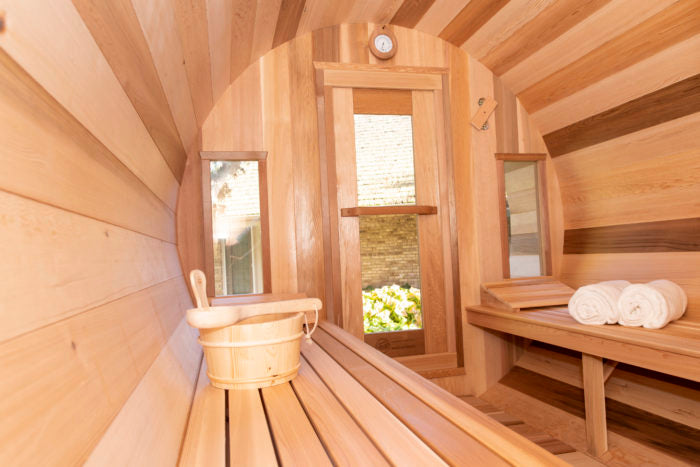The Basic Principles Of Traditional Sauna
The Basic Principles Of Traditional Sauna
Blog Article
Traditional Sauna - The Facts
Table of ContentsThe Facts About Traditional Sauna UncoveredThe smart Trick of Traditional Sauna That Nobody is DiscussingSome Known Questions About Traditional Sauna.Getting My Traditional Sauna To WorkMore About Traditional Sauna
A lot of the weight lost in a sauna is water loss and is re-gained upon rehydrating. Without a doubt sauna can be a vital component of a healthy and balanced weight loss program. To take a look at the distinctions between typical and IR saunas, I will certainly divide these right into verifiable, academic, and produced differences.Therefore, the most popular point in the saunawhich is at the ceiling straight over the sauna heateris generally between 185 and 190 F. Claims that a conventional sauna goes beyond 200 F is merely not real and not applicable for electric saunas offered in the US. The temperature for a far-infrared sauna is generally set in between 120 and 140 F; nonetheless, unlike the standard sauna, the goal in and IR area is not to attain a high temperature level.

When a standard sauna has actually been properly warmed, the sauna walls are cozy, the air temperature has actually accomplished set temperature level and the rocks are very warmed. As an interesting side note, the heated walls and the rocks are releasing far-infrared heat, combined with the heated air, to create an "enveloping warmth".
The Of Traditional Sauna
When the heat is accomplished, the elements cycle on and off to preserve the heat. A lot of standard sauna individuals enjoy pouring water over the rocks to develop heavy steam to increase sauna moisture degrees. The advantages of pouring water over the rocks include: making the room more comfortable, dampening the nasal flows, and permitting the use of aromatherapy by blending essential oils with the water.

When the power enters the body, it triggers the read this post here body temperature to enhance and eventually causes sweat. In an infrared sauna it is necessary for the emitters/heaters to stay on practically frequently. Given that there is no mass of rocks to preserve warmth, the sauna will certainly cool if the emitters shut down.
Traditional Sauna Can Be Fun For Everyone
As discussed above, the sauna bather in an infrared area intends to place himself before running emitters to obtain maximum take advantage of the warm. The home heating time for both areas can be really different, depending upon just how the spaces are used. For a standard sauna, a bather should allow 30-40 minutes for the area to achieve a wanted temperature level and to correctly pre-heat the rocks.

A well built sauna will typically attain a temperature her latest blog level of 150-160 F in regarding 30-40 mins. For hotter temperature levels, the room may require to heat for a longer period.
To some, 15 minutes was "wasted" while the infrared energy heated up the timber panels as opposed to warming a body, while others discover a pre-heated room to be more comfortable and think a raised beginning temperature level is essential to start sweating. The size of recommended use for each and every space is about the same (10-15 mins per session); nevertheless, as a result of the lower air temperature levels and the ability to feel the results of infrared heat faster than a traditional sauna, it is not unusual for a person to spend an overall of 20-30 minutes in an infrared sauna.
Not known Facts About Traditional Sauna

The typical cost per kWH of electrical power in the U.S. is roughly $0.11, so a 4.5 kW heater will cost roughly $.50 to run for one hour, if the heater runs continuously for one hour. Commonly a sauna heater will run for 75% of the first hour and 50% of succeeding hours on since the aspects cycle once the set temperature level is attained.
A 2 person far-infrared space is typically physically smaller sized than a standard sauna, usually concerning 4' x 4' or smaller sized. The IR heating unit is typically 1.5-1.7 kW utilizing a 120 volt 15 amp plug-in solution. Considering that the space can be utilized quicker than a sauna space, we will certainly think the area is made use of for to of an hour consisting of warmth up time.
Ultimately, there is a seldom gone over difference in the social experience between the 2 rooms. While our culture has actually lost some of the social benefit of the conventional sauna experience, it can be really socially satisfying (Traditional Sauna). From household time in the sauna, to heart-felt conversations with loved ones, to sauna partiesthe conventional sauna experience can bring about intimate interacting socially
All about Traditional Sauna
The majority of higher end infrared spaces consist of colored light therapy, audio systems and full-glass fronts.
Report this page